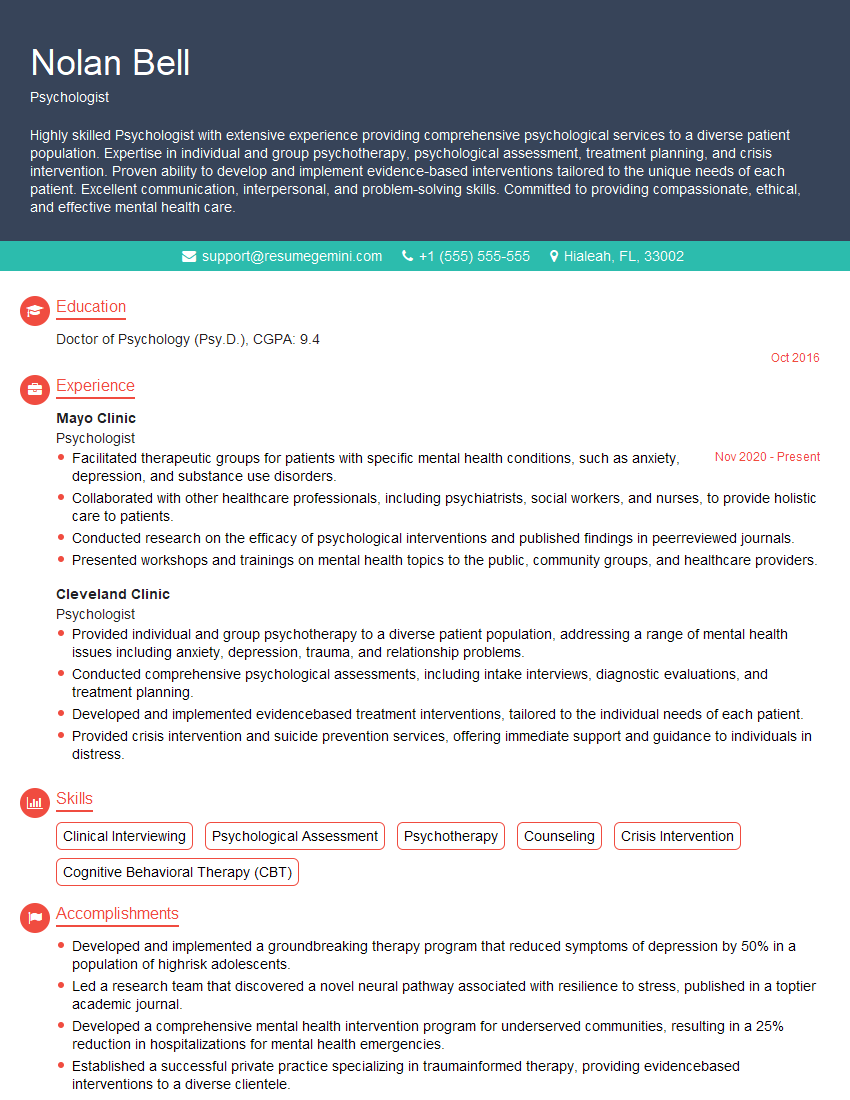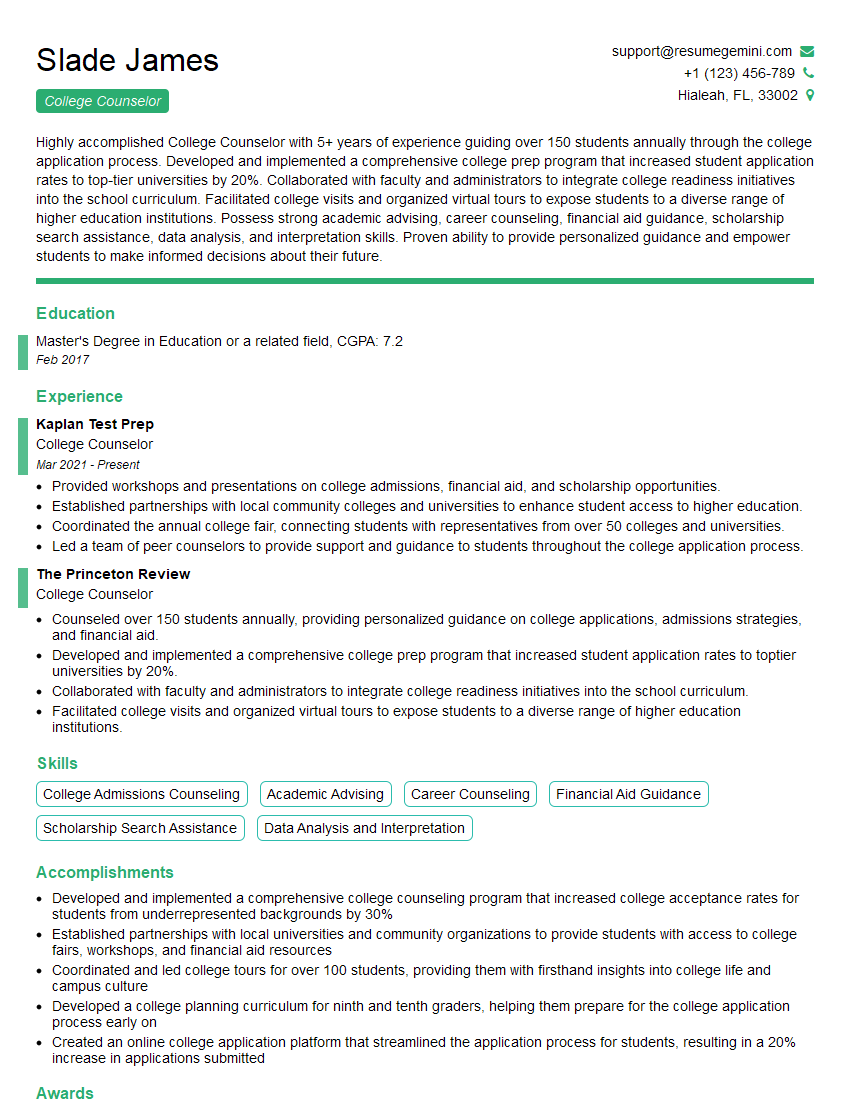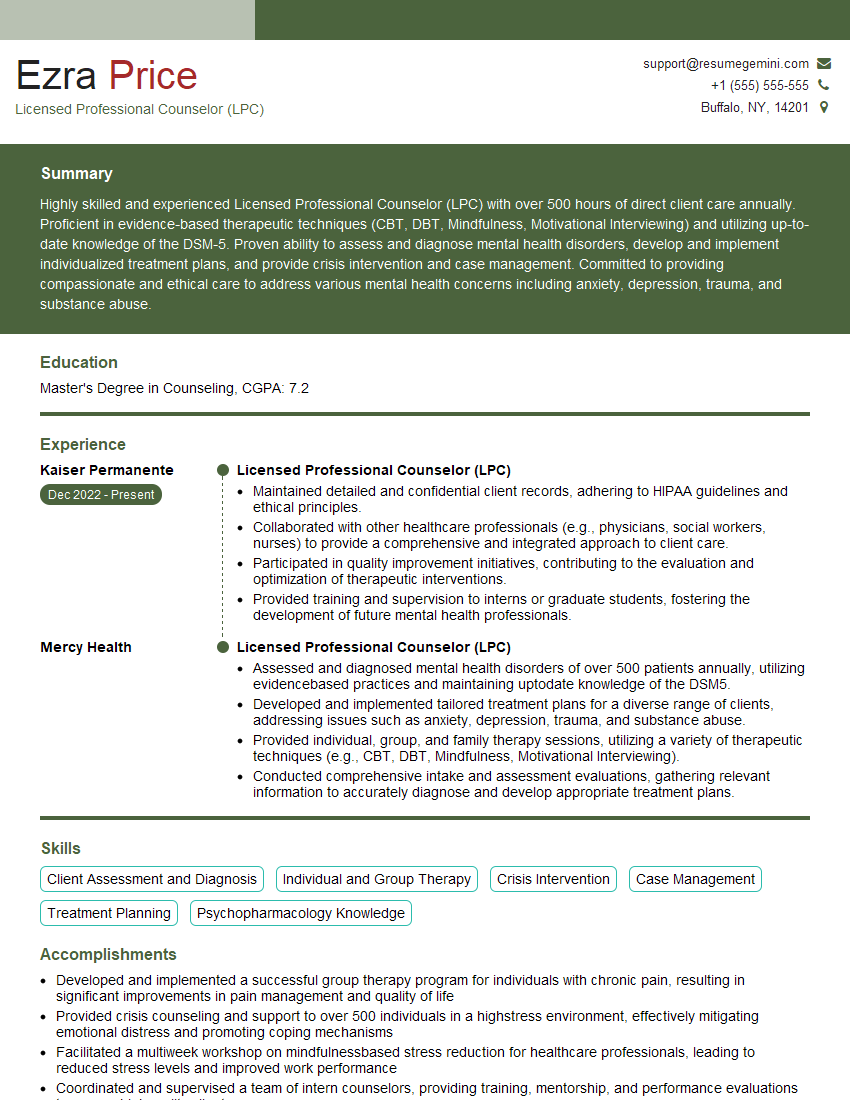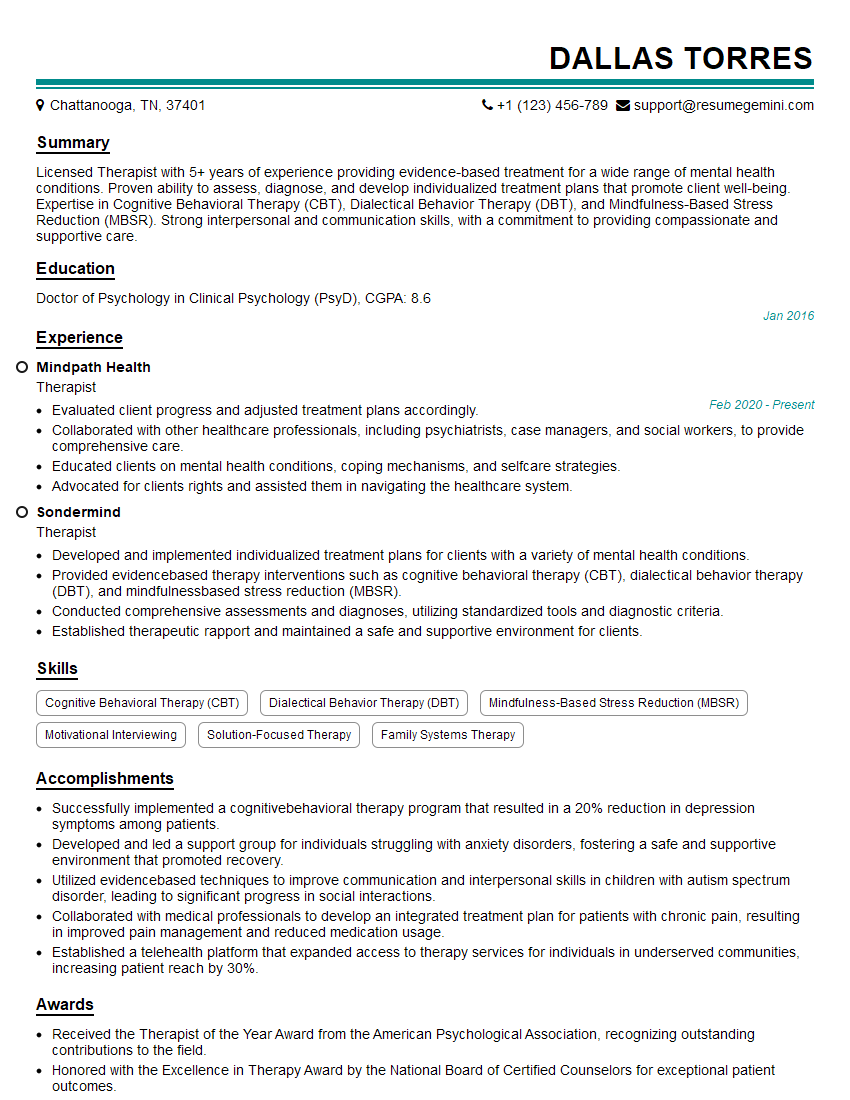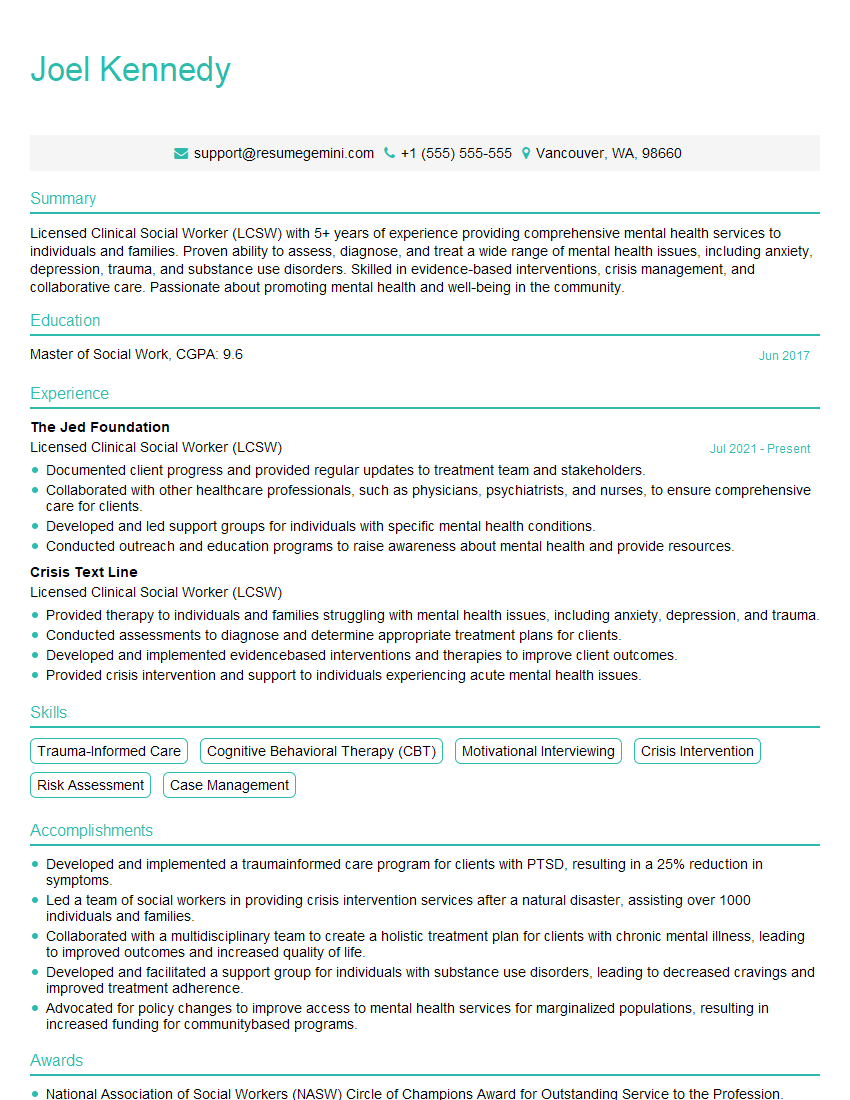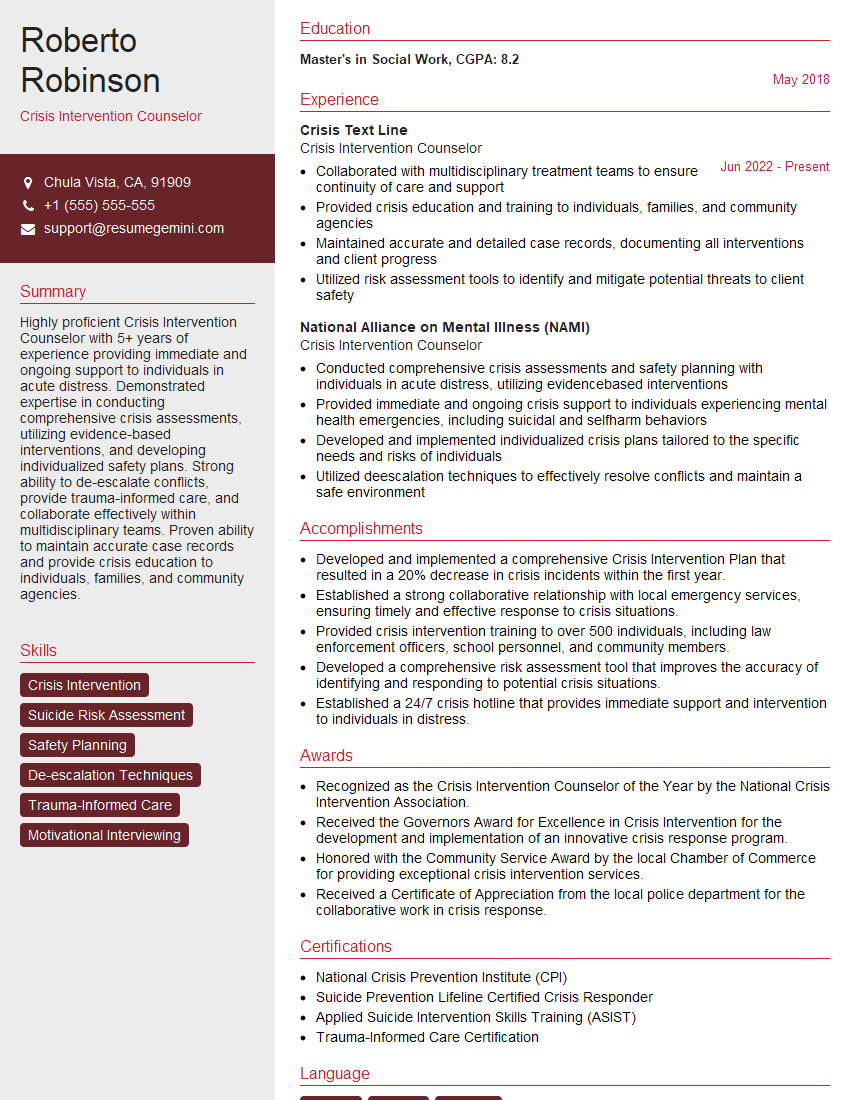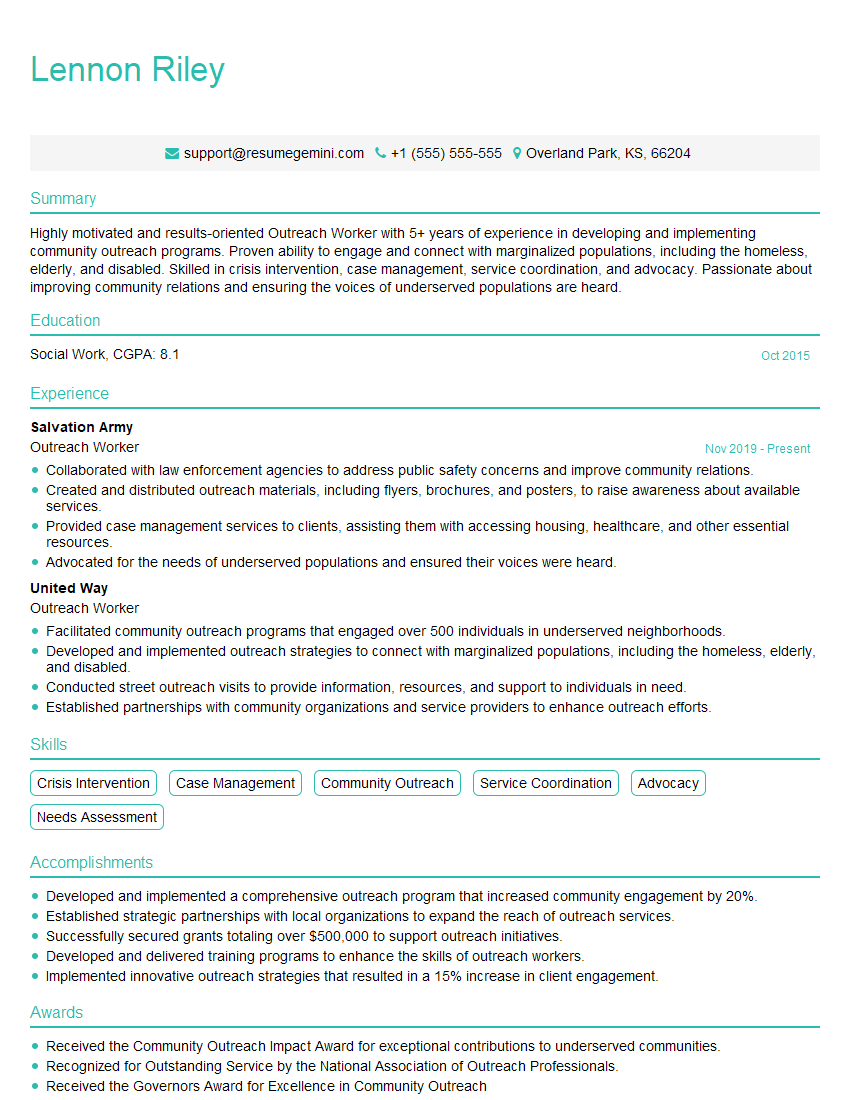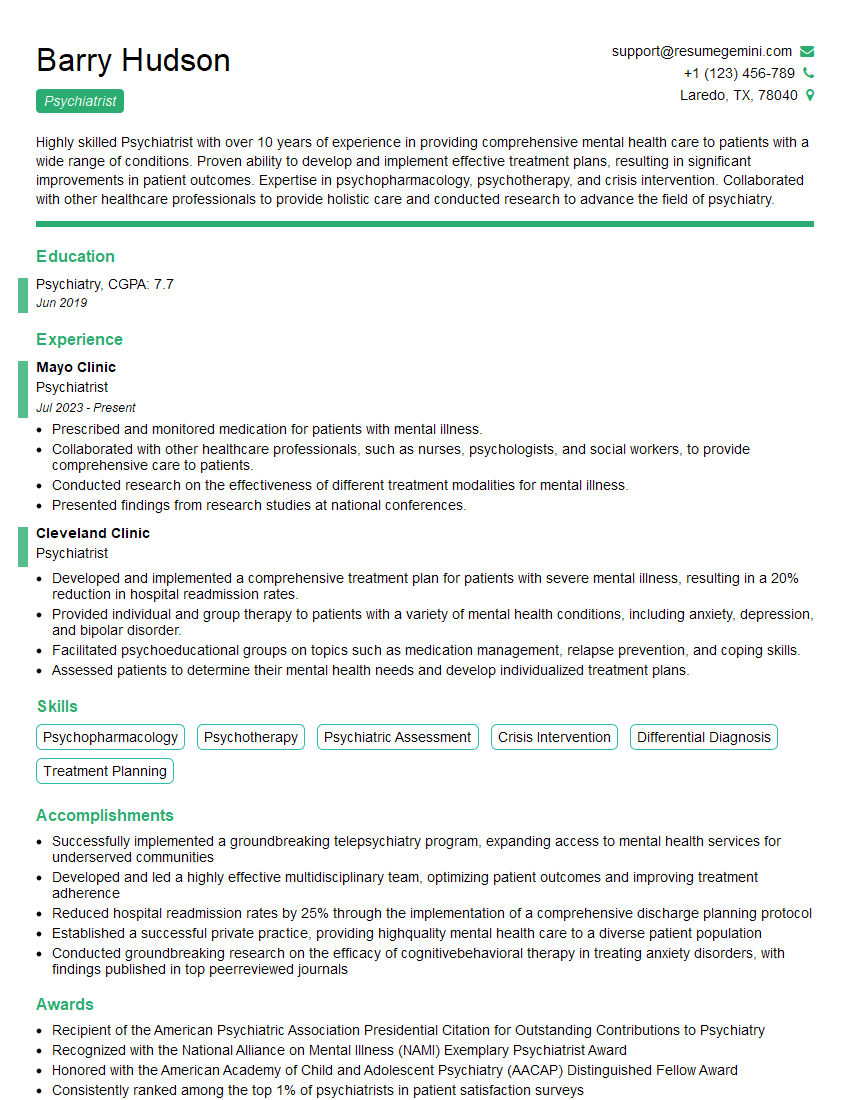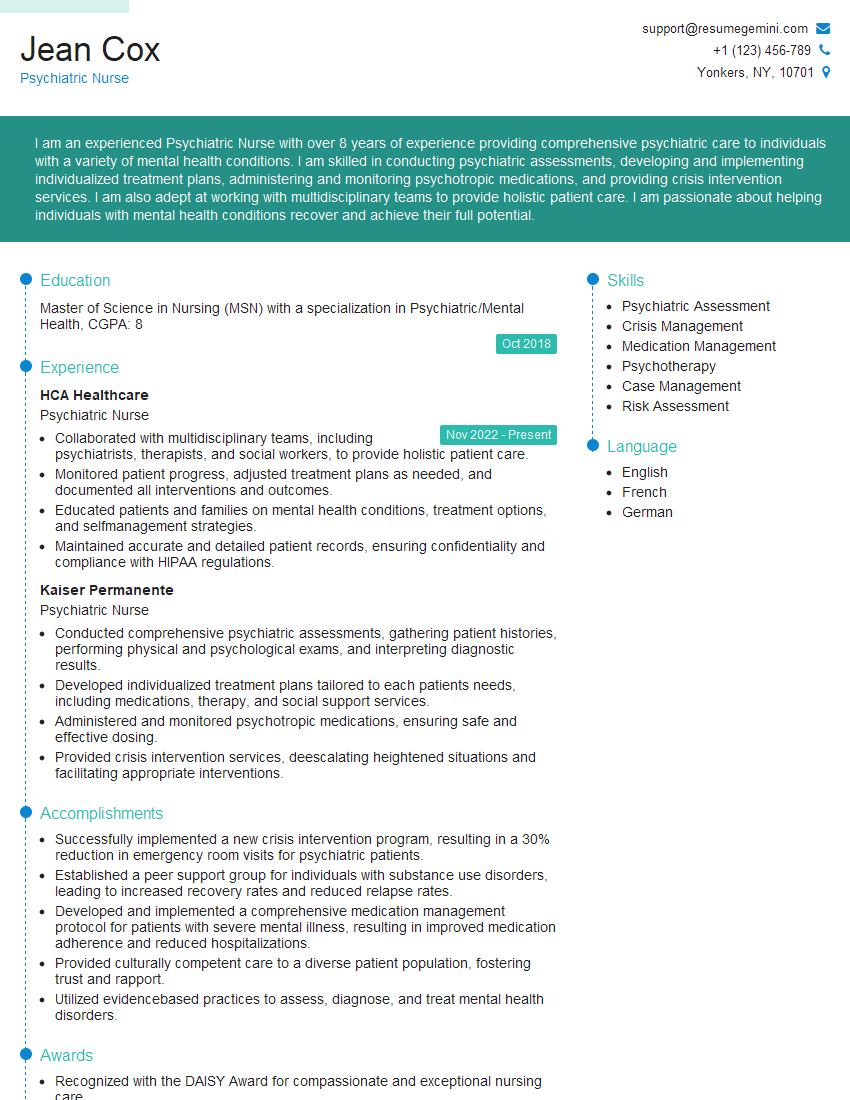Unlock your full potential by mastering the most common Suicide Assessment and Intervention interview questions. This blog offers a deep dive into the critical topics, ensuring you’re not only prepared to answer but to excel. With these insights, you’ll approach your interview with clarity and confidence.
Questions Asked in Suicide Assessment and Intervention Interview
Q 1. Describe your experience conducting suicide risk assessments using standardized tools.
Throughout my career, I’ve extensively utilized standardized tools for suicide risk assessment, including the Columbia-Suicide Severity Rating Scale (C-SSRS) and the Suicide Risk Assessment Scale (SRAS). These instruments provide a structured framework for gathering crucial information about suicidal ideation, intent, and plan. My experience involves administering these assessments, interpreting the results, and integrating them with clinical judgment to formulate a comprehensive risk profile. For instance, using the C-SSRS, I systematically inquire about the presence and severity of suicidal thoughts, behaviors, and plans, allowing for a nuanced understanding of the individual’s current risk level. I then use the gathered data to collaboratively develop an individualized safety plan and treatment strategy tailored to their unique needs.
Beyond standardized tools, I believe in a holistic approach, incorporating qualitative data from clinical interviews and collateral information from family members or other support systems to paint a complete picture of the individual’s circumstances. This ensures a comprehensive and contextualized assessment that goes beyond numerical scores.
Q 2. Explain the difference between suicidal ideation, intent, and plan.
Understanding the differences between suicidal ideation, intent, and plan is critical in assessing risk. Suicidal ideation refers to thoughts of suicide, ranging from fleeting thoughts to persistent preoccupations with death. It’s like a spectrum – some individuals might have passive thoughts of wishing they weren’t alive, while others have active plans. Suicidal intent refers to the individual’s determination to end their life. It’s the level of commitment to acting on their thoughts. A high level of intent indicates a greater risk. Finally, a suicidal plan details the method, time, and location chosen for a suicide attempt. The more specific and detailed the plan, the higher the risk.
Let’s use an example: Someone who reports frequently thinking about death but has no concrete plan (high ideation, low intent, no plan) presents a lower risk than someone who reports persistent thoughts of suicide, expresses a strong desire to die, and has a detailed plan to overdose on medication (high ideation, high intent, detailed plan).
Q 3. What are the key risk factors you consider when assessing suicide risk?
Assessing suicide risk requires considering a multitude of factors, both static and dynamic. Static risk factors are relatively unchanging, like a history of suicide attempts or family history of suicide. Dynamic risk factors are more changeable and include current mood, access to lethal means, and social support.
- History of suicide attempts: Past attempts are strong predictors of future attempts.
- Mental health disorders: Depression, bipolar disorder, schizophrenia, and substance use disorders significantly increase risk.
- Hopelessness and feelings of worthlessness: These profoundly impact an individual’s ability to see a future worth living for.
- Access to lethal means: Easy access to firearms or other lethal means dramatically increases the risk of a successful attempt.
- Social isolation and lack of support: Feeling alone and disconnected greatly increases vulnerability.
- Major life stressors: Job loss, relationship problems, financial difficulties, or legal troubles can trigger suicidal thoughts.
- Traumatic experiences: A history of trauma, abuse, or neglect can contribute significantly to suicidal ideation.
It’s crucial to remember that these risk factors interact; the presence of multiple factors increases the overall risk.
Q 4. How do you differentiate between a suicidal crisis and a non-suicidal crisis?
Differentiating a suicidal crisis from a non-suicidal crisis hinges on the presence of explicit suicidal intent and plan. A suicidal crisis involves an immediate and serious risk of self-harm or suicide. Individuals in a suicidal crisis often express a clear desire to die, have a specific plan, and may be actively preparing for a suicide attempt. A non-suicidal crisis, while distressing and potentially life-altering, doesn’t involve an immediate intent to end one’s life. It could involve other intense emotional states such as severe anxiety, panic attacks, or overwhelming grief.
For example, someone experiencing a panic attack might feel overwhelmed and terrified, but they are not necessarily actively planning or intending to end their life. In contrast, someone expressing a detailed plan to overdose, with immediate access to the means, is clearly in a suicidal crisis requiring urgent intervention.
Q 5. Outline your approach to managing a patient expressing immediate suicidal intent.
Managing a patient expressing immediate suicidal intent necessitates a rapid and decisive response, prioritizing immediate safety. My approach follows these steps:
- Assess the immediate danger: Conduct a thorough risk assessment, focusing on the specific plan, availability of lethal means, and the individual’s level of intent.
- Ensure safety: If there’s an immediate risk, I would prioritize contacting emergency services or hospitalizing the individual. This might involve a voluntary or involuntary admission depending on the level of risk and the individual’s cooperation.
- Reduce immediate stressors: Attempt to reduce immediate stressors that might be contributing to the crisis. This might include connecting them with immediate support, arranging for temporary housing or financial assistance.
- Collaborate with a team: I would consult with colleagues – psychiatrists, social workers, family members – to develop a comprehensive treatment plan.
- Provide immediate support: Offer empathy, validation, and active listening to establish rapport and foster a sense of hope.
- Initiate treatment: Initiate appropriate treatment, which might include medication, therapy, and other interventions. This will be tailored to the individual’s specific needs.
In short, swift action to ensure safety is paramount. This is followed by establishing support, collaboration, and starting treatment.
Q 6. What safety planning strategies do you employ with suicidal individuals?
Safety planning is a collaborative process involving the individual in creating a personalized strategy to manage suicidal thoughts and urges. It empowers individuals to take an active role in their own safety and recovery. My approach involves:
- Identifying warning signs: Working with the individual to pinpoint early warning signs of escalating suicidal thoughts (e.g., increased isolation, changes in sleep, intensified negative thoughts).
- Developing coping strategies: Teaching skills to manage triggers and urges such as deep breathing exercises, mindfulness techniques, or distraction activities.
- Creating a support network: Identifying and strengthening existing support systems (family, friends, support groups) and creating new connections.
- Identifying safe people: Listing specific individuals the person can contact during a crisis.
- Identifying safe places: Listing locations where they can feel safe and supported.
- Developing crisis strategies: Developing a specific action plan for the individual to follow if they are having suicidal thoughts. This may include contacting a crisis hotline, visiting a hospital, or speaking to a trusted friend or family member.
- Creating a positive affirmation list: Focusing on strengths, personal values and reasons for living.
Safety plans are not static; they are regularly reviewed and updated as the individual’s circumstances and needs change.
Q 7. Describe your experience working with individuals from diverse cultural backgrounds experiencing suicidal thoughts.
Cultural factors significantly influence the expression and understanding of suicidal thoughts. My experience working with diverse populations has taught me the importance of cultural sensitivity and humility. I recognize that cultural beliefs, religious practices, and societal norms can significantly shape an individual’s help-seeking behaviors, expression of distress, and attitudes toward suicide. For example, some cultures might stigmatize mental illness, making individuals hesitant to seek professional help. Others may have cultural beliefs that influence their coping mechanisms or perception of suicide.
To effectively work with individuals from diverse backgrounds, I prioritize cultural competence. This involves understanding cultural nuances, avoiding stereotypes, adapting my communication style to be culturally sensitive, and collaborating with community leaders and cultural mediators when necessary to ensure culturally appropriate care. This might involve working with interpreters, seeking knowledge about relevant cultural beliefs, and tailoring interventions to fit the individual’s cultural background while always respecting their autonomy and preferences.
Q 8. How do you handle situations where a patient is unwilling to disclose suicidal thoughts?
Handling a patient’s reluctance to disclose suicidal thoughts requires a delicate balance of trust-building and direct, yet empathetic, questioning. It’s crucial to remember that this unwillingness often stems from fear, shame, or a lack of perceived safety.
My approach begins with validating their feelings and creating a non-judgmental space. I might say something like, “I understand it can be difficult to talk about these things, and I want you to know that you’re safe here and I’m here to listen without judgment.” I then use indirect questioning techniques, focusing on exploring their current challenges and feelings. For instance, instead of asking directly, “Are you thinking about suicide?”, I might ask, “How are you coping with the stress you’re experiencing?” or “What’s been giving you the most difficulty lately?” I pay close attention to their nonverbal cues – body language, tone of voice – as these can often be more revealing than words.
If indirect approaches don’t yield sufficient information and I have serious concerns, I’ll gently but directly address the issue, explaining that my concern for their safety necessitates a frank discussion. I might say something like, “I’m hearing some things that make me worry about your safety, and I want to make sure we explore this together.” I always emphasize my commitment to helping them and working collaboratively to find solutions. Throughout the process, I focus on building rapport and demonstrating genuine care to foster trust and encourage openness. The goal isn’t to force disclosure, but to create an environment where they feel comfortable sharing if they choose to.
Q 9. Explain the importance of collaboration with other professionals in suicide prevention.
Collaboration is paramount in suicide prevention. A multidisciplinary approach involving psychiatrists, psychologists, social workers, nurses, and sometimes even family members and community support systems provides a comprehensive and holistic perspective. Each professional brings unique expertise and insights, contributing to a more accurate assessment, a more effective treatment plan, and a stronger safety net for the individual.
For example, a psychiatrist might provide medication management, a psychologist might offer therapy focusing on cognitive behavioral techniques or trauma-informed care, and a social worker can connect the individual with community resources, such as housing, financial assistance, or support groups. Effective communication and regular case conferences among professionals ensure everyone is on the same page, leading to streamlined care and improved outcomes. This collaborative approach not only improves immediate crisis management but also contributes to long-term recovery and prevention of future suicidal crises.
Q 10. What are the ethical considerations when assessing and intervening with suicidal individuals?
Ethical considerations are central to assessing and intervening with suicidal individuals. The core principles revolve around beneficence (acting in the patient’s best interest), non-maleficence (avoiding harm), autonomy (respecting their right to self-determination), and justice (fair and equitable treatment).
- Confidentiality: While maintaining confidentiality is vital, there are exceptions – mandatory reporting when a patient poses a clear and imminent threat to themselves or others. This requires careful judgment and documentation.
- Informed Consent: Patients must be fully informed about their treatment options, including risks and benefits, before making decisions. This is particularly crucial when considering involuntary hospitalization.
- Competency: Assessing a patient’s competency to make decisions regarding their treatment is critical. If deemed incompetent, a guardian or conservator may be involved in decision-making.
- Least Restrictive Means: Interventions should be as minimally restrictive as possible, while ensuring the patient’s safety. Outpatient treatment is preferred over hospitalization whenever feasible.
Navigating these ethical complexities requires careful consideration, ongoing reflection, and consultation with colleagues when facing difficult dilemmas. Documentation is key in justifying ethical decisions made throughout the assessment and intervention process.
Q 11. How do you document your assessment and intervention efforts?
Thorough and accurate documentation is crucial for legal, ethical, and clinical reasons. My documentation follows a structured format, including the following elements:
- Identifying Information: Patient’s name, date of birth, contact information, etc.
- Reason for Referral/Assessment: What prompted the assessment (e.g., self-referral, referral from a physician, concerning behavior).
- Mental Status Examination: Detailed observation of appearance, behavior, mood, thought process, cognitive function.
- Risk Assessment: Specific risk factors identified (e.g., suicidal ideation, access to means, hopelessness), level of risk (low, moderate, high, imminent), and rationale behind the risk level.
- Intervention Plan: Strategies implemented, including type of therapy, medication, safety planning, and referral to other services.
- Collaboration Notes: Communication with other professionals, family members, or support systems.
- Progress Notes: Regular updates on the patient’s condition, response to treatment, and any changes in risk level.
- Discharge Summary: A summary of the assessment, interventions, and recommendations at the conclusion of treatment.
All documentation adheres to relevant privacy regulations and standards of professional practice. Maintaining complete, accurate, and timely records is essential for ensuring continuity of care, legal protection, and ongoing improvement of services.
Q 12. What are the warning signs of suicide that you would look for?
Recognizing warning signs of suicide requires a holistic approach, considering both verbal and nonverbal cues. There is no single definitive sign, but rather a constellation of indicators that increase risk. Some key warning signs I look for include:
- Verbal Cues: Talking about death, suicide, or self-harm; feeling hopeless, helpless, or worthless; expressing unbearable pain or suffering; saying goodbye to loved ones; making preparations for death (e.g., writing a will, giving away possessions).
- Behavioral Cues: Changes in sleep patterns (insomnia or excessive sleeping); changes in appetite (significant weight loss or gain); withdrawal from social activities; increased substance use; reckless behavior; neglecting personal hygiene; expressing feelings of intense anger, rage, or frustration; sudden improvement in mood (which can sometimes indicate a sudden decrease in suicidal ideation, but must still be closely monitored); increased anxiety or agitation.
- Situational Factors: Significant life stressors (e.g., loss, trauma, relationship problems, financial difficulties); a history of suicide attempts; access to lethal means (e.g., firearms, medications); feelings of isolation and lack of social support; presence of mental health disorders (e.g., depression, anxiety, bipolar disorder, schizophrenia).
It’s crucial to remember that the presence of one or more warning signs doesn’t automatically mean someone is suicidal, but they do warrant further assessment.
Q 13. Describe your experience using crisis de-escalation techniques.
Crisis de-escalation techniques are fundamental in my practice. My approach emphasizes building rapport, active listening, and validation of emotions. I start by creating a safe and calm environment. Then, I use verbal techniques to empathize with the person’s distress, actively listen to their concerns without interrupting, and validate their feelings.
For example, if a patient is agitated and expressing suicidal thoughts, I might say, “I understand you’re going through immense pain right now, and I want to help you through this.” I avoid arguing or minimizing their feelings. Instead, I focus on helping them identify their triggers and coping mechanisms. I may ask questions such as, “What’s making you feel this way right now?” or “What helps you feel calmer when you’re stressed?”
Physical techniques are only used if verbal methods fail and there’s an immediate risk of harm. I always prioritize safety and de-escalation through communication before resorting to any physical intervention. Training in crisis intervention and de-escalation is essential for managing these situations effectively and safely, both for the individual and myself. Ongoing professional development in these areas ensures my skillset remains current and effective.
Q 14. How do you manage a situation where a patient refuses hospitalization?
When a patient refuses hospitalization, despite presenting with significant suicidal risk, a collaborative approach is crucial. It’s critical to respect their autonomy while ensuring their safety.
First, I engage in a thorough discussion to understand their reasons for refusal. I explore their fears, concerns, and alternative plans they may have. I try to collaboratively develop a safety plan involving: regular check-ins with me or other professionals, support systems, removing access to lethal means, and identification of warning signs and coping strategies.
If the risk remains high despite implementing a safety plan, I’ll explore all available options, including seeking a second opinion from a colleague or consulting with legal professionals about involuntary hospitalization. This is a last resort, used only when all other alternatives have been exhausted and there is clear and present danger to the individual’s life. Throughout the process, I maintain open communication, respecting the patient’s autonomy to the greatest extent possible, while prioritizing their safety.
Q 15. What is your understanding of mandated reporting related to suicide risk?
Mandated reporting in the context of suicide risk refers to the legal obligation of certain professionals, such as therapists, doctors, and social workers, to report potential harm to authorities when they have reasonable suspicion that a person intends to harm themselves or others. This is not about gossiping or breaching confidentiality; it’s about prioritizing safety. The exact laws vary by location, but generally involve reporting to child protective services (if the individual is a minor) or to law enforcement or mental health authorities when there’s an imminent threat of suicide.
For example, if a patient explicitly states they have a detailed suicide plan with readily available means, mandated reporting would usually be triggered. The goal isn’t necessarily to hospitalize the individual immediately but to initiate a process that will connect them with the support they need to keep themselves safe.
It’s crucial to understand the nuances of mandated reporting, as it requires a careful balancing act between client confidentiality and the ethical responsibility to protect life. Professionals must thoroughly assess the risk and the patient’s capacity for self-harm, engaging in a collaborative process where possible. It’s also vital to document the process clearly and thoroughly, outlining the assessment, the reasons for reporting, and the steps taken.
Career Expert Tips:
- Ace those interviews! Prepare effectively by reviewing the Top 50 Most Common Interview Questions on ResumeGemini.
- Navigate your job search with confidence! Explore a wide range of Career Tips on ResumeGemini. Learn about common challenges and recommendations to overcome them.
- Craft the perfect resume! Master the Art of Resume Writing with ResumeGemini’s guide. Showcase your unique qualifications and achievements effectively.
- Don’t miss out on holiday savings! Build your dream resume with ResumeGemini’s ATS optimized templates.
Q 16. What resources do you utilize to support individuals at risk of suicide?
Supporting individuals at risk of suicide requires a multifaceted approach leveraging a variety of resources. My toolkit includes:
- Collaboration with other professionals: This is vital. I work closely with psychiatrists, psychologists, social workers, and family members, creating a supportive network.
- Crisis hotlines and mobile crisis teams: These offer immediate support, particularly in situations requiring immediate intervention.
- Inpatient and outpatient mental health services: Access to hospitalization or ongoing therapy is crucial depending on the individual’s needs.
- Peer support groups: Connecting individuals with others who understand their experiences can be invaluable.
- Evidence-based treatments: I utilize therapies such as Cognitive Behavioral Therapy (CBT) and Dialectical Behavior Therapy (DBT), shown to be effective in reducing suicidal ideation.
- Medication management (in collaboration with a psychiatrist): Pharmacological interventions can sometimes be a necessary component of a comprehensive treatment plan.
- Safety planning: Working with the individual to develop a concrete safety plan that includes coping strategies and ways to access support during crisis periods. This plan is not a contract, but a living document developed collaboratively.
The selection of resources is tailored to the individual’s specific needs, risk level, and preferences. It’s always a collaborative process, ensuring that the person feels empowered and involved in their care.
Q 17. Describe a time you had to make a difficult decision regarding a patient’s safety.
I once had a patient, let’s call him Mark, who presented with intense suicidal ideation and a detailed plan. He had access to lethal means and expressed feeling overwhelmingly hopeless. While Mark was legally competent, his judgment was clearly impaired by his emotional state. The decision to hospitalize him involuntarily under a 72-hour hold was agonizing. It meant potentially violating his autonomy, but it was a necessary step to ensure his safety. I had a long discussion with him, explaining my concerns and emphasizing that my priority was to keep him alive. We collaborated on aspects of his care he could influence. While he was initially resistant, he eventually cooperated, and the involuntary hold provided the breathing room for stabilization and the development of a more robust treatment plan. The decision was agonizing, but it ended up saving his life. Ethical decision-making in cases involving suicide risk always involves balancing autonomy and safety, and documentation of that process is vital.
Q 18. How do you maintain your own well-being when working with suicidal individuals?
Working with suicidal individuals is emotionally demanding. Self-care is not a luxury; it’s a necessity to prevent burnout and maintain effectiveness. My strategies include:
- Supervision and peer support: Regular consultation with experienced colleagues allows me to process difficult cases and receive guidance.
- Maintaining healthy boundaries: It’s essential to maintain professional distance without compromising empathy. I avoid taking cases personally.
- Engaging in self-care activities: This includes exercise, spending time in nature, practicing mindfulness, and engaging in hobbies.
- Utilizing stress-management techniques: I use mindfulness exercises, deep breathing, and other relaxation techniques to manage stress.
- Seeking personal therapy: Addressing my own mental health needs is paramount.
Recognizing the inherent emotional toll of this work is crucial. If I don’t prioritize my well-being, I can’t effectively support my clients.
Q 19. What are your thoughts on the effectiveness of different suicide prevention programs?
The effectiveness of suicide prevention programs varies considerably depending on their design, implementation, and target population. Some programs, like those focusing on gatekeeper training (educating the public on recognizing and responding to suicidal behavior) or those based on evidence-based therapies like CBT and DBT, have shown significant promise in reducing suicide rates.
However, programs that lack robust evaluation or don’t adequately address systemic issues such as social isolation, poverty, and access to mental health care are less likely to be effective. Furthermore, a ‘one size fits all’ approach is ineffective. A program effective for young adults might not be as beneficial for older adults. Success hinges on addressing the specific needs of the target group and incorporating feedback to continuously improve the program’s impact. The most effective programs often combine multiple approaches – for example, media campaigns to reduce stigma alongside increased access to mental health services and community support.
Q 20. Explain your understanding of postvention strategies for those bereaved by suicide.
Postvention refers to the support provided to individuals affected by a suicide. This includes family members, friends, colleagues, and even first responders who may have been directly involved. Postvention strategies are crucial in mitigating the long-term psychological effects of a suicide and in preventing further suicides (sometimes referred to as suicide contagion).
These strategies involve providing immediate emotional support, grief counseling, community resource referrals, and education about grief and coping mechanisms. It’s essential to emphasize the importance of self-care and normalizing the range of emotions experienced by those bereaved. A coordinated and compassionate response can significantly reduce the risk of further loss and help survivors navigate their grief in a healthy manner. The immediate and sustained focus is on fostering emotional safety and resilience. Sometimes, this even extends to addressing the practical aspects of managing the aftermath of a suicide.
Q 21. How do you assess the lethality of a suicide plan?
Assessing the lethality of a suicide plan is a crucial part of suicide risk assessment. It’s not just about the presence of a plan, but the specific details. I use a structured approach, considering several factors:
- Specificity of the plan: A vague plan is less lethal than a detailed one outlining the method, time, and location.
- Lethality of the method: Some methods, like using a firearm, are inherently more lethal than others, like cutting.
- Availability of means: Does the individual have access to the chosen method? This is critical.
- Preparation steps: Has the individual already taken steps to prepare for the suicide, such as acquiring materials or writing a suicide note?
- Impulsivity versus premeditation: An impulsive plan might be less lethal than a well-thought-out one.
- Previous suicide attempts: History of attempts increases risk considerably.
It’s important to remember that this assessment is not an exact science. It’s a clinical judgment based on several factors. Even a seemingly low-lethality plan can be highly dangerous if the individual’s desperation and resolve are extremely high. A high-lethality plan calls for immediate intervention, while a low-lethality plan might suggest a different course of action, such as intensive therapy and regular check-ins.
Q 22. How do you handle conflicting information regarding a patient’s suicidal risk?
Conflicting information in suicide risk assessment is common and requires careful consideration. It’s crucial to avoid jumping to conclusions and instead employ a systematic approach. I prioritize gathering information from multiple sources – the patient’s self-report, collateral information from family or friends, observations from clinical staff, and review of past medical records. I look for patterns and inconsistencies. For example, a patient might deny suicidal ideation but exhibit significant behavioral changes such as insomnia, social withdrawal, and reckless behavior. This discrepancy needs further investigation. My approach involves asking clarifying questions in a non-judgmental manner, exploring the context behind conflicting statements, and validating the patient’s feelings regardless of discrepancies. Ultimately, I base my assessment on the most concerning information, erring on the side of caution when faced with conflicting data, particularly if the evidence suggests a higher risk.
Example: A patient might state they don’t want to die, but their statements about their hopelessness and lack of purpose, combined with a detailed suicide plan, would lead me to prioritize the latter information and increase the level of intervention. I’d then focus on understanding the reasons behind this discrepancy, perhaps uncovering underlying fears or shame that prevent them from openly admitting suicidal intent.
Q 23. Describe your familiarity with different types of suicide prevention training.
My training in suicide prevention is extensive and encompasses various approaches. I’m familiar with the QPR (Question, Persuade, Refer) method, which focuses on quickly identifying individuals at risk, persuading them to seek help, and referring them to appropriate resources. I’ve also received training in ASIST (Applied Suicide Intervention Skills Training), a more in-depth program that equips individuals with practical skills to assess suicide risk and intervene effectively. Furthermore, I have completed training in safeTALK, focusing on identifying individuals at risk of suicide and connecting them with professional help. My training also includes understanding different theoretical frameworks for suicide risk, such as the interpersonal-psychological theory of suicidal behavior and cognitive behavioral therapy techniques for managing suicidal ideation. Finally, I’m familiar with the use of standardized risk assessment tools, such as the Suicide Risk Assessment Scale.
Q 24. What are your strengths and weaknesses in relation to suicide assessment and intervention?
My strengths lie in establishing rapport with individuals experiencing suicidal ideation, creating a safe and trusting therapeutic space. I’m skilled in using active listening, empathy, and validation to understand their perspective and underlying needs. My training allows me to perform thorough suicide risk assessments, accurately identify potential warning signs, and develop individualized safety plans. I am also proficient in collaborating effectively with multidisciplinary teams to ensure coordinated and comprehensive care.
One area for development is enhancing my knowledge of specific cultural factors that influence suicide risk and intervention strategies. While I am aware of the broad strokes, I would benefit from more focused training on culturally sensitive approaches to better serve diverse populations. Another area is staying updated with the latest research on suicide prevention and integrating new evidence-based practices into my clinical work.
Q 25. How would you respond to a patient who expresses hopelessness?
Responding to a patient expressing hopelessness requires a compassionate and validating approach. I would begin by acknowledging and validating their feelings. Phrases like, “It sounds like you’re experiencing intense hopelessness right now. That must be incredibly difficult,” create a safe space for the conversation. Then, I would explore the reasons behind their hopelessness, asking open-ended questions like, “Can you tell me more about what’s making you feel this way?” or “What are some of the challenges you’re facing?” It’s crucial to avoid minimizing their feelings or offering platitudes. Instead, I would focus on collaboratively identifying potential strengths, coping mechanisms, and sources of support. I might also introduce hope-focused interventions, such as exploring their past resilience, identifying small achievable goals, and re-framing negative thoughts.
Example: If a patient describes feeling hopeless about their future, I might explore their values, goals, and interests to help them see potential avenues for meaning and purpose. We might collaboratively create a small list of activities they find enjoyable, no matter how small, and work towards incorporating them into their daily life.
Q 26. Describe your experience working within a multidisciplinary team on suicide prevention.
I have extensive experience working within multidisciplinary teams on suicide prevention. This typically involves close collaboration with psychiatrists, psychologists, nurses, social workers, and case managers. In these settings, I contribute to comprehensive risk assessments, developing and implementing safety plans, and coordinating care. My role often involves communicating with team members regularly to share updates on a patient’s progress, identify potential challenges, and adapt the treatment plan as needed. Regular team meetings are crucial for discussing cases, sharing insights, and ensuring consistent care. Effective teamwork requires clear communication, shared decision-making, and a collaborative approach, always prioritizing the patient’s safety and well-being. My experience includes utilizing electronic health records and secure communication systems for effective collaboration across teams.
Q 27. How do you engage families in the support of a suicidal individual?
Engaging families in the support of a suicidal individual is vital, but it requires sensitivity and careful approach. First, I assess the family dynamics and the nature of their relationship with the individual. Some families might be supportive and well-equipped to assist, while others may have complex issues requiring professional mediation. I obtain consent from the individual before engaging the family, ensuring their privacy and autonomy are respected. I then educate the family about suicide risk factors, warning signs, and appropriate responses. I teach them how to listen effectively, offer support without judgment, and connect the individual with professional help. I also facilitate family meetings, providing a space for open communication and helping the family develop strategies for supporting the individual’s recovery. Family support can play a crucial role in creating a safety net and fostering a supportive environment, which is crucial for long-term recovery.
Example: I might provide the family with educational materials on suicide prevention, facilitate communication training, or recommend family therapy sessions.
Q 28. What are your professional development goals related to suicide prevention?
My professional development goals related to suicide prevention include deepening my understanding of specific cultural and socioeconomic factors impacting suicide risk, particularly among marginalized communities. I aim to enhance my skills in utilizing technology and telehealth platforms to expand access to suicide prevention services. I also plan to pursue advanced training in evidence-based interventions like Dialectical Behavior Therapy (DBT) and Cognitive Behavioral Therapy (CBT) for managing suicidal ideation. Finally, I’m committed to staying abreast of the latest research, attending relevant conferences, and engaging in continuing education to ensure my practice remains grounded in the most current and effective methodologies.
Key Topics to Learn for Suicide Assessment and Intervention Interview
- Suicide Risk Assessment: Understanding various assessment tools (e.g., SAD PERSONS scale, Columbia Suicide Severity Rating Scale), interpreting risk factors, and formulating a comprehensive risk profile.
- Intervention Strategies: Applying evidence-based interventions like motivational interviewing, crisis de-escalation techniques, and collaborative safety planning. Practical application includes role-playing scenarios and ethical considerations.
- Understanding Suicidal Ideation and Behavior: Differentiating between suicidal thoughts, ideation, intent, and attempts; exploring underlying psychological factors contributing to suicide risk.
- Mental Health & Co-occurring Disorders: Recognizing the interplay between suicide risk and other mental health conditions (e.g., depression, anxiety, substance abuse) and tailoring interventions accordingly.
- Crisis Management and Referral Pathways: Navigating emergency procedures, utilizing available resources (hotlines, crisis centers, inpatient facilities), and ensuring continuity of care.
- Ethical and Legal Considerations: Understanding mandatory reporting laws, maintaining patient confidentiality (HIPAA), and navigating ethical dilemmas in suicide assessment and intervention.
- Postvention and Support for Survivors: Understanding the impact of suicide on survivors and providing appropriate support and resources. This includes working with bereaved families and colleagues.
- Self-Care and Resilience for Professionals: Developing strategies for managing vicarious trauma and burnout in this demanding field.
Next Steps
Mastering Suicide Assessment and Intervention is crucial for a rewarding career in mental health, opening doors to diverse roles with significant impact. To maximize your job prospects, a well-crafted, ATS-friendly resume is essential. ResumeGemini is a trusted resource to help you create a compelling resume that highlights your skills and experience. We provide examples of resumes tailored to Suicide Assessment and Intervention to guide you in showcasing your qualifications effectively. Invest in your future—build a resume that reflects your expertise and dedication to this vital field.
Explore more articles
Users Rating of Our Blogs
Share Your Experience
We value your feedback! Please rate our content and share your thoughts (optional).
What Readers Say About Our Blog
This was kind of a unique content I found around the specialized skills. Very helpful questions and good detailed answers.
Very Helpful blog, thank you Interviewgemini team.



